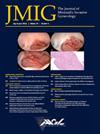视频内窥镜经外阴单切口腹股沟淋巴腺切除术(VEIL-V)
IF 3.5
2区 医学
Q1 OBSTETRICS & GYNECOLOGY
引用次数: 0
摘要
研究目的这项研究评估了外阴手术的一种新型微创单切口技术,旨在提高安全性并减少并发症。设计在标准外阴切口线上切开一个 2 厘米的切口,作为单孔内窥镜淋巴腺切除术的入口。患者或参与者3名外阴鳞状细胞癌患者,FIGO分期Ib期或更低,在伦理批准后接受了手术,无重大禁忌症。干预措施手术包括通过2厘米切口进行单孔插入,用超声刀进行皮下分离,以创建前部工作区AWS。继续扩大 AWS 至腹股沟韧带,外缘至髂前上棘内侧,内缘位于耻骨联合内侧 2 厘米处,向下至股三角顶点。清除大隐静脉周围的淋巴结,优先保护大隐静脉分支。暴露腓肠肌,使股三角区清晰,彻底清除腹股沟浅淋巴结。切开大隐静脉裂孔,切除股动脉和静脉之间的淋巴结以及腹股沟深部淋巴结。结论单切口法缩短了手术路径和切口长度。结论 单切口法缩短了手术路径和切口长度,确保了精确的淋巴结切除,提高了内窥镜的可视性,降低了淋巴和血管损伤的风险,并保持了手术部位皮肤的完整性。本文章由计算机程序翻译,如有差异,请以英文原文为准。
Video Endoscopic Inguinal Lymphadenectomy Via the Vulva Single Incision (VEIL-V)
Study Objective
This study evaluates a novel, minimally invasive single-incision technique for vulvar surgery, aimed at improving safety and reducing complications.
Design
A 2cm incision on the standard vulvar incision line serves as the entry for single port endoscopic lymphadenectomy.
Setting
The procedure involves the patient in lithotomy position with the surgeon operating in between the legs.
Patients or Participants
Three patients with vulvar squamous cell carcinoma, FIGO stage Ib or lower, underwent the surgery post ethics approval, with no major contraindications.
Interventions
The surgery involves a single-port insertion through a 2cm incision, with subcutaneous separation by ultrasonic knife to create an anterior workspace AWS. Continue to expand AWS to the inguinal ligament, the outer edge to the medial anterior superior iliac spine, the inner edge is located 2cm from the inner side of the pubic symphysis, and down to the vertex of the femoral triangle. Remove the lymph nodes around the great saphenous vein, give top priority to the protection of the branches of the great saphenous vein. Expose the sartorius muscle, to make the femoral triangle clear, and completely remove the superficial inguinal lymph nodes. Incise the saphenous vein hiatus resect the lymph nodes between the femoral artery and vein, as well as deep inguinal lymph nodes.
Measurements and Main Results
The surgery duration was 60 minutes with a blood loss of about 10ml. Pathologically, the margins were clear of the tumor, and 13 inguinal lymph nodes were removed without finding metastases.
Conclusion
The single-incision method shortens the operative route and incision length. It ensures precise lymph node removal with enhanced endoscopic visibility, lowers lymphatic and vascular injury risks, and maintains skin integrity at the operative site.
求助全文
通过发布文献求助,成功后即可免费获取论文全文。
去求助
来源期刊
CiteScore
5.00
自引率
7.30%
发文量
272
审稿时长
37 days
期刊介绍:
The Journal of Minimally Invasive Gynecology, formerly titled The Journal of the American Association of Gynecologic Laparoscopists, is an international clinical forum for the exchange and dissemination of ideas, findings and techniques relevant to gynecologic endoscopy and other minimally invasive procedures. The Journal, which presents research, clinical opinions and case reports from the brightest minds in gynecologic surgery, is an authoritative source informing practicing physicians of the latest, cutting-edge developments occurring in this emerging field.

 求助内容:
求助内容: 应助结果提醒方式:
应助结果提醒方式:


